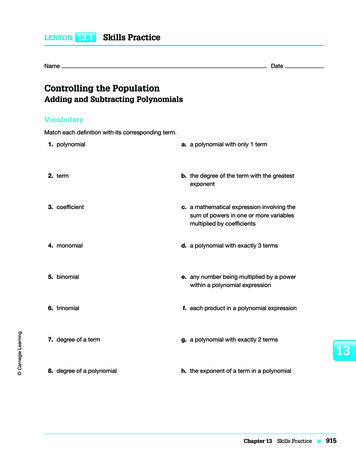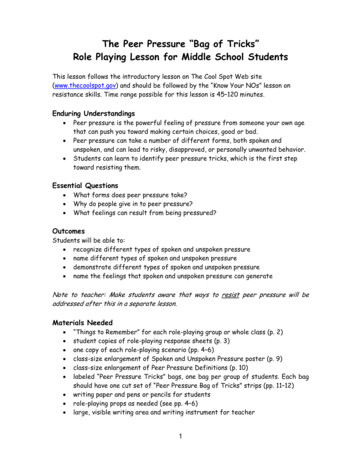
Transcription
Lesson 13.1Skills PracticeNameDateControlling the PopulationAdding and Subtracting PolynomialsVocabulary Carnegie LearningMatch each definition with its corresponding term.1. polynomiala. a polynomial with only 1 term2. termb. the degree of the term with the greatestexponent3. coefficientc. a mathematical expression involving thesum of powers in one or more variablesmultiplied by coefficients4. monomiald. a polynomial with exactly 3 terms5. binomiale. any number being multiplied by a powerwithin a polynomial expression6. trinomialf. each product in a polynomial expression7. degree of a termg. a polynomial with exactly 2 terms8. degree of a polynomialh. the exponent of a term in a polynomialChapter 13 Skills Practice13915
Lesson 13.1Skills Practicepage 2Problem SetIdentify the terms and coefficients in each expression.2. 2m31. 5x 1 8The terms are 5x and 8. The coefficients are5 and 8.3. x2 2 4x4. 23w4 1 w2 2 95. 2186. 10 2 3x3 2 6xDetermine whether each expression is a polynomial. If the expression is not a polynomial, explain whyit is not. 1 8. 6m 2 7. 9 1 12xThe expression is a polynomial.9. 3x 2 8x91611. 22.5m12. x 1 107313. x 1 12 1 14. 4 m 255Chapter 13Skills Practice Carnegie Learning1310. 22w3 1 w2 2 5
Lesson 13.1Skills Practicepage 3NameDateDetermine whether each polynomial is a monomial, binomial, or trinomial. State the degree ofthe polynomial.15. 8x 1 316. 5m 2 The polynomial is a binomial with adegree of 1.17. x2 2 7x18. 29n4 1 6n2 2 119. 21220. 4 2 10x3 1 8xWrite each polynomial in standard form. Classify the polynomial by its number of terms and by its degree.21. 2x 1 6x222. 29m2 1 4m36x2 1 2x Carnegie LearningThe polynomial is a binomial witha degree of 2.23. 10 2 5x24. 7x 2 3 1 12x225. 15 1 4w 2 w326. 5x2 2 15 1 20x1327. 21 2 p428. 26t2 1 4t 1 3t3Chapter 13 Skills Practice917
Lesson 13.1Skills Practice29. 218a3 1 54a 2 22a2page 430. x3 2 x2 2 x5Simplify each expression.31. (5x 2 8) 1 (7x 110)32. (4m2 1 9m) 2 (2m2 1 6)5x 2 8 1 7x 1 10(5x 1 7x) 1 (28 1 10)33. (2x2 1 5x 2 12) 1 (2x2 2 6)34. (10t2 2 3t 1 9) 2 (6t2 2 7t)35. (25w2 1 3w 2 8) 1 (15w2 2 4w 1 11)36. (3x3 1 10x 2 1) 2 (5x2 1 10x 2 9)37. (2a2 1 2a 2 8) 1 (2a2 2 9a 1 15)38. (14p4 1 7p2) 1 (8p3 1 7p2 2 p)39. (3x4 1 3 x2 2 3) 2 (6 x5 2 9 x3 1 2)40. (27m3 2 m2 2 m) 2 (210m3 2 m 2 1)13918Chapter 13Skills Practice Carnegie Learning12x 1 2
Lesson 13.1Skills Practicepage 5NameDateThe graphs of the functions f(x) 5 2x 1 1, g(x) 5 x2 1 x 2 3 , and h(x) 5 f(x) 1 g(x) are shown. Evaluate thefunction h(x) for each given value of x. Use the graph of h(x) to verify your answer.g(x)h(x)y8642024 23 22 211234x222426f(x)41. Evaluate h(x) at x 5 2.2842. Evaluate h(x) at x 5 24.h(x) 5 f(x) 1 g(x)5 2x 1 1 1 x2 1 x 2 35 x2 1 3x 2 2h(2) 5 (2 )2 1 3(2) 2 25416225844. Evaluate h(x) at x 5 1. Carnegie Learning43. Evaluate h(x) at x 5 0.13Chapter 13 Skills Practice919
Lesson 13.1Skills Practice1392046. Evaluate h(x) at x 5 21.5. Carnegie Learning45. Evaluate h(x) at x 5 22.page 6Chapter 13Skills Practice
Lesson 13.2Skills PracticeNameDateThey’re Multiplying—Like Polynomials!Multiplying PolynomialsProblem SetDetermine the product of the binomials using algebra tiles.2. x 1 1 and x 1 41. x 1 1 and x 1 1x1xx2x1x1(x 1 1) (x 1 1) 5 x2 1 2x 1 1 Carnegie Learning3. x 1 2 and x 1 2 4. x 1 3 and x 1 313 Chapter 13 Skills Practice921
Lesson 13.2Skills Practicepage 26. 2x 1 3 and x 1 25. 2x 1 1 and x 1 3 Determine the product of the binomials using multiplication tables.8. 5m 1 3 and 4m 1 67. 3x 1 4 and 2x 1 2?2x23x 6x 2 6x48x8(3x 1 4)(2x 1 2) 5 6 x2 1 6x 1 8x 1 8 5 6 x 1 14x 1 821392210. 4x 1 2 and 4x 2 2 Carnegie Learning9. 6t 1 5 and 7t 2 5Chapter 13Skills Practice
Lesson 13.2Skills Practicepage 3NameDate11. 10w 2 1 and 9w 1 812. y 1 12 and 5y 1 15Determine the product of the polynomials using the Distributive Property.14. 4 x2 (x 1 2)13. 2x(x 1 6)2x(x 1 6) 5 2x(x) 1 2x(6) Carnegie Learning5 2 x2 1 12x15. 7x(x 2 5)16. (2x 1 1)(x 1 8)17. (x 1 3)( x2 2 1)18. (4x 1 4)(5x 2 5) 19. 3x( x2 1 5x 2 1)1320. 9x(3 x2 2 4x 1 2) Chapter 13 Skills Practice923
Lesson 13.2Skills Practicepage 421. (x 1 2)( x2 1 6x 2 1) Carnegie Learning22. (x 2 4)( x2 1 2x 2 3)13924Chapter 13Skills Practice
Lesson 13.3Skills PracticeNameDateWhat Factored Into It?Factoring PolynomialsVocabularyState the given property.1. Symmetric Property of EqualityProblem SetFactor out the greatest common factor of each polynomial, if possible.1. x 2 1 9x2. m2 2 4m Carnegie Learningx(x 1 9)3. 5 x2 1 20x 2 154. 24 w2 2 165. y 3 2 7y6. 2 x3 1 10 x2 7. 3w 1 108. 20 x3 1 16 x2 1 8x139. 7 m3 2 2110. 15 x3 1 4Chapter 13 Skills Practice925
Lesson 13.3Skills Practicepage 2Factor each trinomial using an area model.11. x 2 1 4x 1 3x13x11x111xx2xxx1x111x 2 1 4x 1 3 5 (x 1 1)(x 1 3)12. x 2 1 5x 1 6 Carnegie Learning13. x 2 2 x 2 613926Chapter 13Skills Practice
Lesson 13.3NameSkills Practicepage 3Date14. x2 2 x 2 12 Carnegie Learning15. x 2 1 7x 1 1016. x 2 1 3x 2 413Chapter 13 Skills Practice927
Lesson 13.3Skills Practicepage 4Factor each trinomial completely using multiplication tables. If possible, factor out the greatest commonfactor first.18. y2 1 13y 1 4217. x2 2 2x 2 8?x2xx 2 2x2424x2819. m2 1 6m 2 720. x2 2 9x 1 1821. 4 w2 1 12w 2 4022. 2 t3 2 14 t2 1 24t23. 3 m 3 1 36 m2 1 60m24. 2 x2 2 8x 2 4213928Chapter 13Skills Practice Carnegie Learningx 2 2 2x 2 8 5 (x 2 4)(x 1 2)
Lesson 13.3Skills Practicepage 5NameDateFactor each polynomial using the trial and error method. If possible, factor out the greatest commonfactor first.26. w2 1 6w 2 1625. x 2 1 11x 1 10The factors of the constant term, 10, are:21, 210 1, 1022, 25 2, 5x 2 1 11x 1 10 5 (x 1 1)(x 1 10)27. m2 1 2m 2 3528. x 2 1 4x 2 1229. 3 n2 2 27n 1 6030. 2 x2 1 22x 1 60 Carnegie LearningFactor each polynomial.31. x 2 1 11x 1 28 5 (x 1 4)(x 1 7)32. x 2 1 10x 1 9 5x 2 2 11x 1 28 5 (x 2 4)(x 2 7)x 2 2 10x 1 9 5x 2 1 3x 2 28 5(x 2 4)(x 1 7)x 2 1 8x 2 9 5x 2 2 3x 1 28 5(x 1 4)(x 2 7)x 2 2 8x 2 9 533. x 2 1 12x 1 27 534. x 2 1 13x 1 40 5x 2 2 12x 1 27 5x 2 2 13x 1 40 5x 2 1 6x 2 27 5x 2 1 3x 2 40 5x 2 2 6x 2 27 5x 2 2 3x 2 40 513Chapter 13 Skills Practice929
Lesson 13.3Skills Practicepage 635. x 2 1 12x 1 11 536. x 2 1 13x 1 36 5x 2 2 12x 1 11 5x 2 2 13x 1 36 5 x2 1 10x 2 11 5 x2 1 5x 2 36 5x 2 2 10x 2 11 5x 2 2 5x 2 36 5Factor each polynomial completely. If possible, factor out the greatest common factor first.37. x 2 1 4x 1 438. x 2 2 10x 1 25?x2xx 2 2x22x4x 2 1 4x 1 4 5 (x 1 2)(x 1 2)40. 45 1 4w 2 w2 41. 5 x2 1 10x 2 1542. 4 x2 1 32x 1 64 Carnegie Learning39. 232 2 12m 2 m2 13930Chapter 13Skills Practice
Lesson 13.4Skills PracticeNameDateZeroing InSolving Quadratics by FactoringVocabularyComplete the definition of the Zero Product Property.1. The Zero Product Property states that if the product of two or more factors is equal to, then at least one factor must be equal toIf ab 5 0, thenor.This property is also known as the.Define the term in your own words.2. rootsProblem SetFactor and solve each quadratic equation. Check your answer.1. x2 1 5x 1 6 5 0 x2 1 5x 1 6 5 0(x 1 3)(x 1 2) 5 0Check:(2 3) 2 1 5(23) 1 6 5 0(2 2) 2 1 5(22) 1 6 5 0x 1 3 5 0 or x 1 2 5 0 9 2 15 1 6 5 0 4 2 10 1 6 5 0x 5 23 or x 5 22 0 5 00 5 0 Carnegie LearningThe roots are 23 and 22.2. x 2 2 3x 2 4 5 013 Chapter 13 Skills Practice931
Lesson 13.4Skills Practicepage 23. m2 1 2m 2 35 5 04. 2 x2 2 4x 1 12 5 05. x 2 1 8x 5 06. w2 1 50 5 215w13 Carnegie Learning7. 2 t2 1 12t 5 32932Chapter 13Skills Practice
Lesson 13.4Skills PracticeNamepage 3Date8. x2 1 2x 1 2 5 09. 2 t2 1 t 2 3 5 0 Carnegie Learning10. w2 1 5w 2 32 5 2w 2 413Chapter 13 Skills Practice933
Lesson 13.4Skills Practicepage 4Determine the zeros of each quadratic function, if possible. Check your answer.11. f(x) 5 x2 2 5xf(x) 5 x2 2 5xCheck:0 5 x 2 5x(0 )2 2 5(0) 0 02(5 )2 2 5(5) 0 00 5 x(x 2 5) 0 2 0 0 0 25 2 25 0 0x 5 0 orx 2 5 5 0 0 5 0 0 5 0x 5 0 or x 5 5The zeros are 0 and 5.12. f(x) 5 3 x2 1 6x13. f(x) 5 x2 1 11x 1 301314. f(x) 5 x2 2 9x 2 36934Chapter 13Skills Practice Carnegie Learning
Lesson 13.4Skills PracticeNamepage 5Date15. f(x) 5 2 x2 1 9x 1 1016. f(x) 5 x2 1 5x 1 14 Carnegie Learning17. f(x) 5 3 x2 1 3x 2 613Chapter 13 Skills Practice935
Lesson 13.4Skills Practicepage 6 3 x18. f(x) 5 1 x 2 224 Carnegie Learning 13936Chapter 13Skills Practice
Lesson 13.5Skills PracticeNameDateWhat Makes You So Special?Special ProductsVocabularyGive an example of each term. Then, factor the expression.1. perfect square trinomial2. difference of two squares3. sum of two cubes Carnegie Learning4. difference of two cubesProblem Set13Factor each binomial completely.1. x 2 252 x 2 25 5 (x 1 5)(x 2 5)23. x 3 1 272. x 2 643 4. m2 2 100Chapter 13 Skills Practice937
Lesson 13.5Skills Practicepage 25. 5 x3 1 406. t3 2 1257. 8 a3 2 278. x 8 2 y8 Factor the trinomial completely.9. x 2 1 16x 1 6410. k 2 2 20k 1 100x 2 1 16x 1 64 5 (x 1 8)(x 1 8)11. 2 x2 2 28x 1 9812. 5 x2 1 10x 1 513. z 3 1 18 z2 1 81z14. 3x 3 2 30 x2 1 75xDetermine the root(s) of each quadratic equation. Check your answer(s).15. x 2 2 100 5 0x 2 2 100 5 0(x 1 10)(x 2 10) 5 0Check:(2 10) 2 2 100 0 0( 10) 2 2 100 0 0x 1 10 5 0 or x 2 10 5 0 100 2 100 0 0 100 2 100 0 0x 5 210 or x 5 10 0 5 00 5 01393816. m2 2 16m 1 64 5 0Chapter 13Skills Practice Carnegie LearningThe roots are 210 and 10.
Lesson 13.5Skills PracticeNamepage 3Date17. 6 x2 1 24x 1 24 5 018. 4 x2 2 9 5 0 Carnegie Learning19. t 2 1 22t 1 121 5 020. 12 w2 2 48w 1 485 013Chapter 13 Skills Practice939
Lesson 13.5Skills Practicepage 4Determine the zero(s) of each quadratic function. Check your answer(s).21. f(x) 5 x2 2 225f(x) 5 x2 2 225Check:0 5 x 2 225(215 )2 2 225 0 02(15 )2 2 225 0 00 5 (x 1 15)(x 2 15) 225 2 225 0 0 225 2 225 0 0x 1 15 5 0 orx 2 15 5 0 0 5 0 0 5 0x 5 215 or x 5 15The zeros are 215 and 15.22. f(x) 5 x2 1 x 1 1 4 23. f(x) 5 9 x2 2 1 Carnegie Learning 13940Chapter 13Skills Practice
Lesson 13.5Skills PracticeNamepage 5Date24. f(x) 5 8 x2 2 48x 1 7225. f(x) 5 8 x2 2 5026. f(x) 5 2 x 2 1 52x 1 338 Carnegie Learning13Chapter 13 Skills Practice941
Carnegie Learning13942Chapter 13Skills Practice
Lesson 13.6Skills PracticeNameDateCould It Be Groovy to Be a Square?Approximating and Rewriting RadicalsVocabularyChoose the word that best completes each statement.square rootpositive (principal) square rootradicandnegative square rootextract the square rootradical expression1. When solving certain quadratic equations, it is necessary tosides of the equation.2. Every positive number has both a(n).3. Thefrom bothand a(n)is the expression enclosed within a radical symbol.4. A number b is a(n)of a if b 2 5 a.5. An expression involving a radical symbol is called a(n).Problem SetRewrite each radical by extracting all perfect squares.1. 25 2. 144 25 5 65 Carnegie Learning3. 400 4. 12 135. 32 6. 45 Chapter 13 Skills Practice943
Lesson 13.6Skills Practicepage 27. 300 8. 5 54 Determine the approximate value of each radical expression to the nearest tenth.10. 37 9. 7 2. 62 5 6.762. 72 5 7.29 7 2.611. 96 12. 27 13. 109 14. 405 Solve each quadratic equation. Approximate the roots to the nearest tenth.15. x 2 5 40 x2 5 4016. m 2 5 68 x 2 5 6 40 6. 3 2 5 39.69136. 42 5 40.96 40 66.3x 66.3The roots are approximately 6.3 and 26.3.944Chapter 13Skills Practice Carnegie Learningx 5 6 40
Lesson 13.6Skills Practicepage 3NameDate17. t2 5 1518. x 2 5 8319. (x 2 5) 2 5 2220. (x 1 8) 2 5 29Solve each quadratic equation. Rewrite the roots in radical form.21. x 2 5 48 x2 5 48 Carnegie Learning22. x 2 5 52 x 2 5 6 48 x 5 6 48 13x 5 6 16 ? 3 x 5 6 16 ? 3 x 5 64 3 The roots are 4 3 and 24 3 .Chapter 13 Skills Practice945
Lesson 13.6Skills Practice24. x 2 5 17525. (12 2 x) 2 5 826. (x 1 20) 2 5 80 Carnegie Learning23. x2 5 2713946page 4Chapter 13Skills Practice
Lesson 13.7Skills PracticeNameDateAnother MethodCompleting the SquareVocabularyDefine the term in your own words.1. completing the squareProblem SetUse a geometric figure to complete the square for each expression. Factor the resulting trinomial.1. x2 1 2x2. x2 1 4x1x1xx2xx1x 2 1 2x 1 1 5 (x 1 1) 2 4. x 2 1 9x Carnegie Learning3. x 2 1 12x13Chapter 13 Skills Practice947
Lesson 13.7Skills Practicepage 26. x2 1 28x5. x2 1 11xDetermine the unknown value that would make each trinomial a perfect square.7. x 2 2 10x 1 259. x 2 18. x 2 1 14x 110. x 2 2x 1 911. x 2 1 7x 1x 1 8112. x 2 2 15x 113. x 2 214. x 2 1x 1 1699x 1 4 Determine the roots of each quadratic equation by completing the square. Round your answer to thenearest hundredth. Check your answer.15. x 2 1 4x 2 6 5 0 x 1 4x 5 62x 2 1 4x 1 4 5 6 1 4 (x 1 2) 2 5 1013 (1.16) 2 1 4(1.16) 2 6 0 01.3456 1 4.64 2 6 0 0 (25.16) 2 2 4(25.16) 2 6 0 026.6256 2 20.64 2 6 0 020.0144 020.0144 0 (x 1 2) 5 6 10 2x 1 2 5 6 10 x 5 22 6 10 x 1.16 or x 25.16The roots are approximately 1.16 and 25.16.948Chapter 13Skills Practice Carnegie LearningCheck:x 2 1 4x 2 6 5 0
Lesson 13.7Skills PracticeNamepage 3Date16. x2 2 2x 2 4 5 017. x 2 1 10x 1 2 5 0 Carnegie Learning18. x2 2 12x 1 25 5 013Chapter 13 Skills Practice949
Lesson 13.7Skills Practicepage 419. x2 1 3x 2 1 5 0 Carnegie Learning20. x 2 1 x 2 10 5 013950Chapter 13Skills Practice
Chapter 13 Skills Practice 917 13 Lesson 13.1 Skills Practice page 3 Name Date Determine whether each polynomial is a monomial, binomial, or trinomial. State the degree of the polynomial. 15. 16.8x 1 3 The polynomial is a binomial with a degree of 1. 5m2 417. 2x2 2 7x 18. 29n 1 6n 2 1 19. 212 20. 4 2 10x3 1 8x Write each polynomial in standard .











